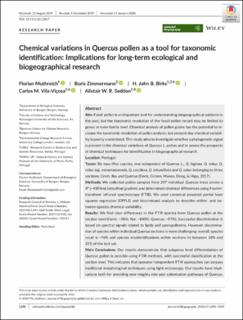Chemical variations in Quercus pollen as a tool for taxonomic identification: Implications for long-term ecological and biogeographical research
Muthreich, Florian; Zimmermann, Boris; Birks, Harry John Betteley; Vila-Vicosa, Carlos M; Seddon, Alistair
Journal article, Peer reviewed
Published version

Åpne
Permanent lenke
https://hdl.handle.net/11250/2739080Utgivelsesdato
2020Metadata
Vis full innførselSamlinger
- Department of Biological Sciences [2211]
- Registrations from Cristin [9450]
Sammendrag
Aim
Fossil pollen is an important tool for understanding biogeographical patterns in the past, but the taxonomic resolution of the fossil‐pollen record may be limited to genus or even family level. Chemical analysis of pollen grains has the potential to increase the taxonomic resolution of pollen analysis, but present‐day chemical variability is poorly understood. This study aims to investigate whether a phylogenetic signal is present in the chemical variations of Quercus L. pollen and to assess the prospects of chemical techniques for identification in biogeographical research.
Location
Portugal.
Taxon
Six taxa (five species, one subspecies) of Quercus L., Q. faginea, Q. robur, Q. robur ssp. estremadurensis, Q. coccifera, Q. rotundifolia and Q. suber belonging to three sections: Cerris, Ilex and Quercus (Denk, Grimm, Manos, Deng, & Hipp, 2017).
Methods
We collected pollen samples from 297 individual Quercus trees across a 4° (~450 km) latitudinal gradient and determined chemical differences using Fourier‐transform infrared spectroscopy (FTIR). We used canonical powered partial least squares regression (CPPLS) and discriminant analysis to describe within‐ and between‐species chemical variability.
Results
We find clear differences in the FTIR spectra from Quercus pollen at the section level (Cerris: ~98%; Ilex: ~100%; Quercus: ~97%). Successful discrimination is based on spectral signals related to lipids and sporopollenins. However, discrimination of species within individual Quercus sections is more challenging: overall, species recall is ~76% and species misidentifications within sections lie between 18% and 31% of the test set.
Main Conclusions
Our results demonstrate that subgenus level differentiation of Quercus pollen is possible using FTIR methods, with successful classification at the section level. This indicates that operator‐independent FTIR approaches can surpass traditional morphological techniques using light microscopy. Our results have implications both for providing new insights into past colonization pathways of Quercus, and likewise for forecasting future responses to climate change. However, before FTIR techniques can be applied more broadly across palaeoecology and biogeography, our results also highlight a number of research challenges that still need to be addressed, including developing sporopollenin‐specific taxonomic discriminators and determining a more complete understanding of the effects of environmental variation on pollen‐chemical signatures in Quercus.
